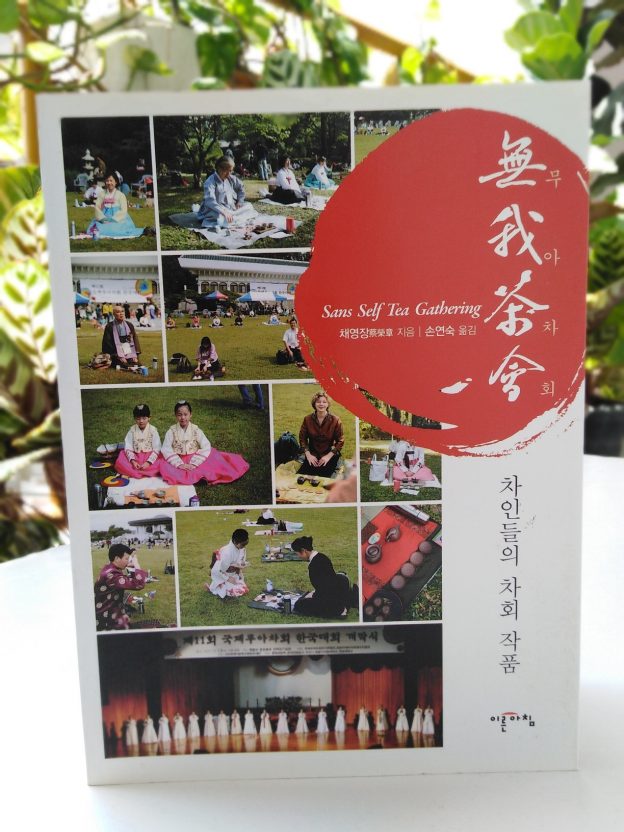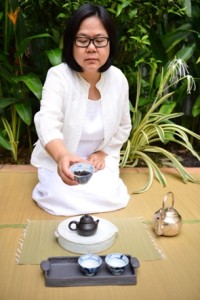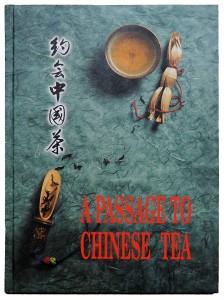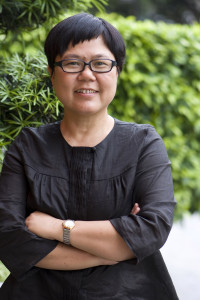《無我茶會Sans Self Tea Gathering (Wu-Wo Tea Ceremony)180條》
蔡荣章著Author:Rong-tsang Tsai
ISBN 978-957-9690-08-9,“无我茶会Sans Self Tea Gathering(Wu-Wo Tea Ceremony) 180” ,First edition: 1999.9, Second edition: 2010.9.《无我茶会180条》,1999.9第一版,2010.9第二版.台北陆羽茶艺股份有限公司.2012.05.20修订版.-English Translator : Katherine Yip,英语翻译:叶德明.
Chapter 12 Promoting Sans Self Tea Gatherings and its Meaning
156. How should we promote ‘Sans Self Tea Gathering’?
To promote Sans Self Tea Gathering, the Chinese International Sans Self Tea Gathering Promotion Association has engaged ‘Sans Self Tea Gathering Instructors’ and ‘Teachers of the Way of Tea’ to conduct classes and training at both permanent and ad hoc locations, while encouraging these teachers to introduce systematic ‘Classes on the Way of Tea’ at fixed venues. The curriculum covers not only Sans Self Tea Gathering but also other areas of the study of tea.
157. Incorporating Sans Self Tea Gathering into the curriculum of courses on the Way of Tea
Following the initial efforts in promoting Sans Self Tea Gathering, this unique form of tea gathering has been incorporated into the curriculum of various courses of the Way of Tea. Sans Self Tea Gatherings are organized the world over. 《Sans Self Tea Gathering: Tea Gathering as an artistic manifestation of the Way of Tea》is an elementary textbook for the teaching of Sans Self Tea Gathering.
158. Setting up ‘Sans Self Tea Gathering’ Community Centre
We wish that ‘Sans Self Tea Gathering’ Community Centre can be set up at different places for fellow tea drinkers to attend regularly-held Tea Gatherings. A weekly Sans Self Tea Gathering could be scheduled, and participants may get acquainted with each other before and after the tea gathering. Practices can be held regularly at the Community Centre when it is not used for hosting Sans Self Tea Gatherings. Similarly, the venue can be used for imparting knowledge about tea.
159. The importance of integrity to Sans Self Tea Gathering
The tea ware for Sans Self Tea Gathering can be of any design, which makes it simple for a beginner to put together a tea set for the occasion. Meanwhile, a complete set of user-friendly tea ware not only boosts one’s interest but also the desire to acquire the necessary items when one has built up his confidence.
It is fine to prepare ten to twenty sets of spare tea ware for beginners for practice purposes, but the students must be asked to acquire their own set when they have reached a certain stage in course of practice.
160. Flexibility and Reach of Sans Self Tea Gathering
Sans Self Tea Gathering is a very flexible form of gathering. It encourages floor seating, thus eliminating the need of tables and chairs. Participants bring along their own tea ware, seating mat and boiled hot water. As such, it is possible to have the tea gatherings both indoors and outdoors.
For Sans Self Tea Gathering, there is no need of any event conductor or leader. There is also practically no limit to the number of participants — it does not matter if some participants are blocked by buildings or knolls on site, or they spread across miles. Meanwhile, participants can offer tea to onlookers during a Sans Self Tea Gathering if this is intended for the event. For example, if there are 100 participants, and each brews four cups of tea for the onlookers, 400 onlookers will be served; and if each participant brews two rounds of four cups each, they will be brewing a total of 800 cups, which means that 800 onlookers will be served. If the Organizer has arranged for a presenter, he will brief a substantial number of onlookers the nature of ‘Sans Self Tea Gathering’ and ‘the Way of Tea’ as the event progresses. The reach and spread that can be achieved by a Sans Self Tea Gathering needs no further illustration.
161. How could we highlight the style and characteristics of Sans Self Tea Gathering?
It is important to emphasize the characteristics of a Sans Self Tea Gathering as soon as you begin promoting it. Make it clear that no one should speak once brewing starts, and there is no arrangement for guests to make speeches, etc. Otherwise, the special style of Sans Self Tea Gathering will be overlooked and undermined. If the Organizer fails to insist on the standard practice right from the start – for fear of the gathering becoming too serious – and allows fellow tea drinkers to engage in conversation while sipping tea and taking snacks, participants will think that there is no difference between Sans Self Tea Gathering and ordinary tea gathering, with the only exception being the loop formation and floor seating. This way, the unique characteristics of Sans Self Tea Gathering will become oblivious in due course.
To promote Sans Self Tea Gathering the way it should be, a clear understanding of the practice and meaning is essential. This is the only way to stay true to the format and convince participants and partners. For example, if a co-organizer requests to have the person-in-charge of their company deliver a speech, explain to him that this is inappropriate. Or, the musician invited for the post-tea performance may think that a five-minute performance is too short and ask for a longer introduction, explain clearly the reason behind this arrangement. Such clarification is important to the promotion of Sans Self Tea Gathering.
162. Why is there no arrangement for VIP seating and speech of attending officials?
There is no special seating arrangement – in the midst, outside or inside the loop formation – for local celebrities or attending officials. We welcome these guests to draw lots for seating and brewing as other participants. This is every way as appropriate as having these guests seated ‘apart from the rest’. If they are unable to brew with the others but like to learn more about or advocate such tea gatherings, invite them to stay outside of the loop formation and observe or be served tea like the other onlookers.
Likewise, speech-giving by the attending official would clash with the unique style of Sans Self Tea Gathering. Instead, invite the official to brew and serve tea along with the participants. This could be more impactful. Our experience shows that the official would agree to substitute speech-giving with tea-brewing, provided we explain the procedure and meaning of Sans Self Tea Gathering in details. If he wants to give special messages during the occasion, the Organizer may suggest to have him do so during the group photo session, or after the tea gathering, or during ‘post event activities’.
163. Why don’t we have background music during a Sans Self Tea Gathering?
No music is played or being performed throughout a Sans Self Tea Gathering – from the time when registration begins to packing up – because it may weaken the ‘flavour’ of such a unique tea gathering and does not serve the purpose of music appreciation. Some people may think that background music can contribute to the atmosphere; the reality is, music can be a source of distraction; this would be worse if the songs are familiar to us. Without music, we will channel all our attention to tea, brewing, interpersonal relationship and the spirit of the tea gathering. This way, the style of Sans Self Tea Gathering will become more prominent, and the impact of the Way of Tea on everyone present will be stronger.
Music can be introduced after the last cup of tea to accentuate the ‘beauty of the void’. At this juncture, everyone at the tea gathering can sit back and listen to the music, while relishing the aftertaste of the tea. If more time for music appreciation is preferred, the Organizer may allocate a longer period for music performance as part of the ‘post-event activities’.
164. ‘Post-tea activities’ would best be carried out by participants
Organizing a Sans Self Tea Gatherings should be hassle-free. It is important to keep administration to a minimum; there are no specially-appointed organizing team members – tasks are shared by fellow tea drinkers (with the exception of special tasks such as video filming). By the same token, it would be best if participants are responsible for post-tea activities. They may stay in their respective places, or move slightly to the side where the musical instrument is, and sing or play a piece of music. This is the easiest way to fulfil the intention of illustrating the ‘beauty of the void’ because the performers are also participants.
165. Organizing a promotional Sans Self Tea Gathering
Any quiet place will be good for a Sans Self Tea Gathering among friends. However, if a Sans Self Tea Gathering is to be organized to create awareness among members of the public, it is advisable to find a popular spot with a lot of traffic. It is essential to have a presenter at promotional Sans Self Tea Gathering; otherwise, onlookers would be at a loss. Meanwhile, it would be more effective to get onlookers warm up to the idea of Sans Self Tea Gathering if they will be offered tea.
To enhance the effect of a Sans Self Tea Gathering where the public will be briefed, prepare a set of written information introducing this form of gathering, including places where those interested can take relevant lessons. It is even better if the Organizer can include a ‘trial’ tea gathering at the end of the tea gathering. Find out how many people are interested, and assign one participant as mentor to each person interested. These mentors would lend their sets of tea ware to the newcomers. As the presenter explains the procedure, the newcomers will practise with the help of their mentors by the side. This is ideal as the newcomers can put into practice – with readily-available tea ware –what they saw and heard a while ago. Pre-event preparation would be necessary. The Organizer should remind participants to bring one extra flask of hot water (or have hot water refill on site), an additional cup (or have paper cups for everyone), and put more tealeaves in the teapot (the same tealeaves can be used for brewing during this trial round).
166. Application of Sans Self Tea Gathering for other occasions
Sans Self Tea Gathering is an occasion when tea is used as a means to get together. It can also be adopted in the following ways:
a. As a teaching method for ‘tea identification’ in the study of the Way of Tea. For example, the teacher will divide students into groups of four and ask each one in a group to bring along a certain kind of tea. Adopting the format the Sans Self Tea Gathering, each member of a group will serve the tea brewed with tealeaves he has brought along. As the end, each member of a group would have sampled and learned about the characteristic of each of the four teas.
b. As a form of practice for brewing in the study of the Way of Tea. For example, the teacher will bring along, or ask the students to bring along a particular tea, with which everyone will practice brewing according to the format of Sans Self Tea Gathering. This way, each student will be able to drink four cups of the same kind of tea (assuming each serves four cups) and assess if each cup is well brewed or poorly brewed.
c. As a form of engagement or wedding ceremony. The time for ‘Tea Ware Appreciation and Networking’ session can be used for the engagement or wedding ceremony, after which the newly-wed couple can brew with fellow tea drinkers. The bride and groom serve tea to each other’s parents; while other participants serve tea according to the agreed conditions of Sans Self Tea Gathering (The seats of the bride and groom are considered those of non-brewers). ‘Serving tea to onlookers’ is effectively serving tea to guests attending the ceremony. Post-tea activities could be singing by friends and relatives, and the tea gathering may or may not be followed by a wedding banquet. What’s being advocated by Sans Self Tea Gathering can be applied to marriage, and adopting the tea gathering as a form of wedding ceremony is both symbolic and appropriate.
d. The tea gathering can also be held in memory of a person. For this purpose, The time for ‘Tea Ware Appreciation and Networking’ session can be used for ‘paying tribute to a person ’, followed by participants offering their first cup of tea to the subject of tribute. After this, tea could be offered to fellow tea drinkers or other participants of the memorial gathering. Post-tea activities could be chanting or group singing of remembrance. Such arrangement enables the subject of tribute to take the same cup of tea with everyone present – and ‘drinking literally from the same cup’ makes the occasion so much more touching and memorable.
167. ‘Sans Self Tea Gathering’ in English, Japanese and Korean
Sans Self Tea Gathering is known as 「無我茶會」in Chinese, Japanese and Korean, as the Chinese-, Japanese- and Korean-speaking audiences can readily recognized the term. In English, this unique form of tea gathering was first translated as Anatman Tea Convention, followed by Wu-wo Tea Ceremony. In spring 2012, we decided to rephrase it to ‘Sans Self Tea Gathering’, given the fact that the tea gathering celebrates the realization of ‘無’, literally ‘the absence of’ or ‘void’. ‘無我’ should be understood as ‘I who understand the idea of nothingness’. Sans, an archaic French word meaning ‘without’, has been made popular by some of the greatest literary works through the ages, including William Shakespeare’s comedy “As You Like It”. To call it a tea gathering, instead of a tea ceremony, is to better reflect its nature as the founders see it.
168. What is the International ‘Sans Self Tea Gathering’ Organization?
Tea drinkers in different countries and regions have undertaken to promote Sans Self Tea Gathering. They take turn to host large scale ‘International Sans Self Tea Gathering’ at regular intervals at agreed locations. The Organizer of an international Sans Self Tea Gathering is the Sans Self Tea Gathering Organization of the country or region. The Leaders’ Convention of an International Sans Self Tea Gathering is the occasion when member organizations of the International Sans Self Tea Gathering Organization meet up to discuss issues pertaining to the promotion of Sans Self Teat Gathering and the host of the upcoming event.
169. Is there a need of a standardized flag and anthem for the Sans Self Tea Gathering?
We had introduced a flag and an anthem for Sans Self Tea Gathering when it was first launched. These are still used in certain countries and regions. However, they have not been stated as the standardized flag and anthem, because we do not regard this an important issue.
170. What is the meaning behind ‘Sans Self Tea Gathering’ ?
‘Sans Self Tea Gathering’ is a way of thinking and a form of tea gathering pertaining to the study of tea. ‘Sans Self’ should be understood as ‘I who understand the idea of nothingness’. Only in the state of ‘nothingness’ can ‘something’ be born. One can hardly attain wellbeing if one’s mind is preoccupied with wealth, fame, status, beauty and endless chores. The state of nothingness is neither a state of ignorance nor death. An analogy of such a state will be the colourless light which is effectively a convergence of different colours. The colours in our life are distilled by ‘tea’; this enables us to enter into a state with an ‘absence of colours’.
171. Sans Self Tea Gathering for one to thousands and millions of participants
Sans Self Tea Gathering may have begun with one person. When a person brews and enjoys tea with no disturbance or distraction, it is more likely that he can savour the taste of tea, understand the brewing process, contemplate how a brewer’s state of mind affects the taste of tea, calm himself and come face to face with his true self. In fact, we encourage everyone to take tea alone, and look upon this as the basis of the Way of Tea.
When you have a clear idea of what it is like having tea on your own, you may invite your closest friend and ‘have both drinking tea alone’ – the two of you will brew tea on your own, serve each other tea, all in silence. A deeper understanding between you two can be achieved in the course of brewing, serving and drinking tea. As distraction is kept to the minimum, you will understand each other better. You will be able to experience more and learn the way to staying quiet in others’ presence. When you have achieved an understanding of a state of nothingness in the presence of another person, you may proceed to invite a small group of three to five good friends, and introduce them to this way of having tea. Practise the Way of Tea together in the spirit of ‘emptiness and solitude’. Feel the tranquility and freedom in the midst of a larger group. This way, the number of people for a Sans Self Tea Gathering can reach thousands and millions.
(2254)




